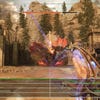Immortals of Aveum pushes Unreal Engine 5 hard - and image quality suffers
Lumen and Nanite at 60fps? Something has to give.
After five years of development, Immortals of Aveum has landed, with the distinction of being the first non-Epic game to ship on Unreal Engine 5 using all of its next generation features. There's Nanite micro-geometry and ray-traced Lumen lighting, along with virtual shadow maps. Not only that, the developers are aiming for 60 frames per second exclusively, meaning there's no 30fps fidelity option. Some might say that developer Ascendant has made a rod for its own back here, bearing in mind that UE5 is still a nascent technology, so can the game deliver on its promise? Does image quality hold up? Does it sustain 60 frames per second - and what about Xbox Series S?
Immortals of Aveum has plenty of visual high points. We have the vast backdrops of its tutorial - a sweeping mountain range lit in real-time thanks to Lumen. We get the opening city of Lucium, a geometrically complex sprawl of houses, markets, bridges, windmills, NPCs. You name it, the details stack up and up. And it's here that UE5's Nanite helps in rendering the entire city in real-time, while keeping the frame-rate target at 60fps. Beyond this, each later chapter presents almost as a self-contained showcase for Unreal Engine 5's features. From the siege at the city gates - filling the horizon with particle effects - to a ruins area replete with trees and waterfalls, there's a great sense of variety across the board.
All of which brings us to Immortal's first - and most obvious - drawback: image quality. Despite UE5 realising the team's often eye-catching art direction, the game isn't always flattered by its scaling method. PS5 and Series X target 4K using AMD's FSR 2.1 temporal upscaling. The base resolution this is scaling from though is a much lower figure - at 1280x720 on each. Every shot tested so far comes in at 720p - on camera cuts in cinematics, or at the screen's edges in gameplay. This points to FSR 2's ultra performance mode being used, or in other words, 33 per cent scale of the target 4K output. And honestly in still frames - static shots - it does look better than that number might suggest, resolving nicely as the information from prior frames stacks up to generate a convincing-looking final resolve.
Inevitably though, any movement, especially with fine detail on-screen, produces clear scaling artefacts. We get noise - almost like a fizzling effect. Curiously it's also noted that PS5 resolves with a sharper image overall, despite sharing the same base resolution with Series X - a point that possibly suggests a different post-processing treatment between the two. Even more notable is the state of Xbox Series S. Again this version targets 60fps - and resorts to FSR 2 scaling to get there. The base resolution here though comes in at around 768x436, resulting in a much blurrier image, and even more pixel breakup than the other two machines.
As it stands, Immortals has rough edges on all three machines - but more so on Series S. The specular highlights on the city's gold decals break up easily. And even the detailing on our hand turns into pixellated noise any time we switch amulets. Ultimately, these spots don't flatter the work put into the game's otherwise on-point art direction. It's also worth noting the FSR 2 mode is adaptive, adjusting based on PS5 or Series X's output resolution. So for example, by outputting either machine at 4K, the FSR mode is set to ultra performance, or 33 per cent scale - 720p. However, supposing you have a 1080p monitor connected, the game switches to FSR 2 quality mode instead - or 66 per cent of 1080p. In the end, this puts us back at that base 720p resolution.
In theory, your output resolution could affect the frame-rate - even if marginally - given FSR 2's target resolution is a factor for performance. However I did the legwork here and compared 1080p and 4K output modes on PS5 and in truth there's little difference either way in frame-rates.
In terms of design, Immortals of Aveum has another unique twist in that it's a magic-themed first person shooter. It's a welcome break from the well worn staple of guns, guns and more guns in modern FPS titles, so blasting all manner of spells from each hand creates a unique technical workout for PS5 and Series X with particle effects and transparencies flying in all directions. It becomes a spectacular deluge of colour and sparks, often overwhelming the screen.
All of this leverages Unreal Engine's 5's Niagara system to manipulate the same effect asset for different results. At peak action, the spells themselves are impressive, and it's a clear mark of a true current-gen title that it's all possible with 60fps in mind. The only odd point I've noticed is how god rays render at a low resolution on PS5, Series X and especially Series S. Certain effects also update at just 30fps - half refresh, which stands out when gameplay runs at 60.
It's clear Immortals of Aveum's technical delivery is mixed. The concept art is brimming with scale, its effects splash across the screen in proud excess, and it's all well realised on Unreal Engine 5. But then, image quality on PS5, Series X and in particular Series S don't show it all in the best light. There are issues with low quality effects, 30fps elements too.
Added to this, there's also what appears to be a bug resulting in select enemies and NPCs appearing without any shadows at all. You name it, from guards to major bosses - at times, shadow fail to render, meaning they present as if they've hovering over the scene. All of these issues apply to PS5, Series X and Series S alike as of patch 1.02. Series S has additional quirks too, with more texture pop in generally, plus I had an unfortunate software lock within the first ten minutes of play.
If we focus just on the Xbox machines, almost every aspect of Immortals' visual design is dropped a setting for the 4TF machine. First up there's world detail. In the ruins area of chapter three, grass, rocks and entire trees are stripped out from the scene. Sometimes the contrast is huge. Series S pushes for 60fps - but to get there has involved a big hit, leaving it with much more barren-looking environments. Another example is in the garrison area near the city: the wood planks on the floor, the flags around its alleyways are all removed. You'll also see geometry, shadow, and object LOD settings are drawn back on Series S - resulting in more pop-in overall.
The list of cutbacks goes on for Series S, and it's fascinating to see how far Ascendant went to keep its performance up to scratch. For one, you'll notice a lower setting for shadows. Series S appears to use a lower volumetric lighting preset as well, creating more aliasing on those streaks of light. Additionally, texture quality - in places at least - takes a hit, along with the overall quality of certain effects. The rest of the cutbacks are less clear-cut in comparison and mostly boil down to its lower native rendering reslution. Screen-space reflections and ambient occlusion are close in quality between the Xbox machines, for example. In fact, puddle reflections quality is similar, if not for the often missing geometry and grass detail nearby. Overall then, the biggest downside for Series S is without a doubt its lower image quality, stripped world detail, and extra pop-in.
PS5 shares all the same settings as Series X. Shadows, textures, world detail, draw distances - you name it, they're broadly identical, though curiously, PS5 has higher settings on its menu screen, which runs at a slower frame-rate as a result. In-game, 60fps is the target, and it's well met for much of the time, even if performance can drop in the busiest scenes. With any heightened use of spells, or boss battles, the frame-rate at times wavers down to 50fps, 40fps and even just under. The cause is clear: overloading the screen with spells, across dense, complex environments does the trick. And at its extremes we have a drop to the 40fps line on Sony's machine. Xbox Series X is also variable in its performance, but typically smoother than PS5, with a 5-10fps increase in performance in the most challenging scenes.
Bringing Series S into the equation, its frame-rate goes one of two ways. Firstly, in the city - the opening chapter - it's worse than PS5 and Series X. It's really in the first explosive set-piece as we run through the streets that performance gets hammered. In this case it trails Series X by as much as 10fps as we navigate busy, geometry heavy areas. But, in general play, across this first chapter, Series S still runs at a solid 60 otherwise. For slowly navigating the slums there's zero issue. The good news here is, later forest areas, and the siege with dragons flying overhead actually tend to run better than PS5 and Series X. The junior Xbox's visuals may be brutally cut back, but it does play out closer to 60fps in select missions, even if performance can be lower elsewhere.
Overall, Immortals of Aveum is one of the most fascinating games I've reviewed in a while, even with its issues. Between the focus on current-gen development, its use of Unreal Engine 5.1 features - nanite and lumen - there's a genuine ambition to push for cutting edge tech. But yes, it's also clear Immortals has technical issues that need solving. The image break-up using FSR 2 doesn't present the world in the best way, in large part stemming from low base resolutions on PS5, Series X and S. There are shadow bugs, and at times each struggles to hit its 60fps target - especially in big set-pieces.
That's the console situation and we'll be returning to Immortals of Aveum soon to discuss the situation on PC - but it's not exactly a spoiler to say that this one's going to be challenging on the hardware side too.























